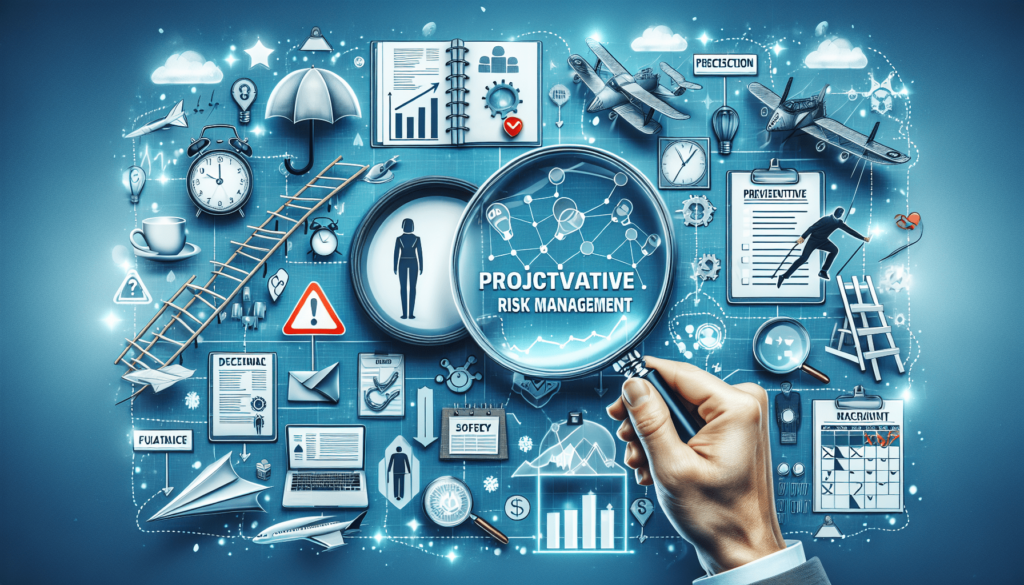In today’s fast-paced and ever-changing 윈조이머니상 business landscape, the importance of active risk management cannot be overstated. Whether you are a seasoned entrepreneur or just starting, being able to effectively identify, assess, and mitigate risks is crucial for the success and longevity of your venture. Active risk management not only helps you navigate uncertainties and protect your business from potential hazards, but it also allows you to seize opportunities and make strategic decisions with confidence. By proactively managing risks, you can stay ahead of the curve and ensure a more secure and resilient future for your business.

Understanding Risk Management
Definition of Risk Management
Risk management is the process of identifying, assessing, and prioritizing potential risks, and then taking proactive measures to mitigate or address those risks. It involves analyzing both internal and external factors that could impact a project or an organization and developing strategies to minimize negative outcomes. By implementing risk management practices, organizations can improve decision-making, increase project success rates, and protect their overall operations.
The Purpose of Risk Management
The primary purpose of risk management is to enable organizations to anticipate and control potential risks, minimizing the likelihood and impact of negative events. By identifying risks early on, organizations can take steps to mitigate or avoid them, reducing potential losses and improving project outcomes. Additionally, risk management helps organizations prioritize their resources, ensuring that efforts are directed toward the most critical risks. Ultimately, the goal of risk management is to enhance organizational resilience and promote long-term sustainability.
Types of Risks
Risks can come in various forms and from different sources. Some common types of risks include:
-
Strategic Risks: These are risks associated with the overall direction and objectives of an organization. They include competition, market changes, and changes in government regulations.
-
Operational Risks: These risks are related to the day-to-day operations of an organization. They include issues such as equipment failure, supply chain disruptions, and human errors.
-
Financial Risks: Financial risks involve the potential impact on an organization’s financial performance. This can include risks related to currency exchange rates, interest rates, and investment fluctuations.
-
Compliance Risks: These are risks associated with adhering to legal and regulatory requirements. Non-compliance can result in fines, legal issues, and reputational damage.
-
Reputational Risks: Reputational risks involve the potential harm to an organization’s brand or reputation. This can include negative publicity, customer dissatisfaction, and social media backlash.
By understanding these different types of risks, organizations can develop targeted risk management strategies to address each category effectively.
Benefits of Active Risk Management
Early Identification of Risks
One of the key benefits of active risk management is the early identification of potential risks. By actively engaging in the risk management process, organizations are better equipped to identify and assess risks before they escalate into major issues. This allows for timely intervention and the implementation of proactive strategies to minimize the impact of these risks. Early identification of risks also enables organizations to allocate resources effectively, ensuring that they are focused on addressing the most critical risks.
Minimization of Potential Losses
Active risk management plays a vital role in minimizing potential losses for organizations. By actively assessing and analyzing risks, organizations can develop effective risk response strategies to mitigate the negative impact of those risks. This may include implementing contingency plans, diversifying resources, or establishing alternative solutions. By proactively planning for potential risks, organizations can significantly reduce the financial and operational damages that may result from these risks.
Increased Likelihood of Project Success
Another significant benefit of active risk management is the increased likelihood of project success. By actively managing risks, organizations can anticipate potential obstacles and develop strategies to overcome them. This enables them to stay on track and achieve project objectives within the defined timelines and budgets. Active risk management allows for better decision-making, as potential risks are carefully evaluated and considered in the project planning and execution phases. As a result, organizations can greatly increase their chances of completing projects and meeting stakeholder expectations.
Components of Active Risk Management
Risk Identification
Risk identification is the first step in active risk management. It involves systematically identifying potential risks that may impact an organization or project. This can be done through various techniques, such as brainstorming sessions, historical data analysis, and expert interviews. The goal of risk identification is to create a comprehensive list of risks that can be further analyzed and prioritized.
Risk Analysis
Once risks are identified, the next step is to analyze them. Risk analysis involves evaluating the likelihood and impact of each identified risk. This analysis helps in understanding the severity of each risk and allows organizations to prioritize their resources accordingly. Risk analysis can be done using qualitative or quantitative methods, depending on the complexity of the risks and the available data.
Risk Response Planning
After risks have been identified and analyzed, organizations need to develop risk response plans. These plans outline specific actions or strategies to manage the identified risks. Risk response planning may involve risk avoidance, risk mitigation, risk transfer, or risk acceptance. The goal is to select the most appropriate response strategy for each risk and develop a clear implementation plan.
Risk Monitoring and Control
Risk monitoring and control are essential components of active risk 윈조이머니상 management. This involves continuously monitoring identified risks, evaluating the effectiveness of risk response plans, and making necessary adjustments as needed. Regular monitoring ensures that risks are kept under control and that changes in the risk landscape are promptly addressed. This allows organizations to stay proactive and maintain effective risk management practices throughout the project or organizational lifespan.
Key Principles of Active Risk Management
Proactive Approach
Active risk management requires a proactive approach, where organizations anticipate and respond to potential risks before they become significant issues. By actively seeking out risks and addressing them early on, organizations can minimize their impacts and avoid unnecessary disruptions or losses.
Continuous Assessment and Adjustment
Risk management should be an ongoing process, with continuous assessment and adjustment. As the risk landscape evolves, organizations need to adapt their risk management strategies accordingly. This involves regularly reviewing and refining risk identification, analysis, and response plans. By continuously evaluating risks and adjusting strategies, organizations can maintain effective risk management practices over time.
Integration with Decision-Making Processes
Effective risk management should be integrated into an organization’s decision-making processes. This means that potential risks should be carefully considered during strategic planning, project initiation, and day-to-day operations. By incorporating risk management into decision-making, organizations can make informed choices, taking into account potential risks and their respective impacts.
Clear Communication and Collaboration
Open and clear communication is critical in active risk management. Stakeholders, team members, and management need to be aware of the identified risks, response strategies, and monitoring processes. Collaboration among different departments or stakeholders is also key to ensuring consistent risk management practices and gathering diverse perspectives on potential risks. Clear communication and collaboration help in fostering a risk-aware culture and maximizing the effectiveness of risk management efforts.

Tools and Techniques for Active Risk Management
Risk Assessment Matrix
A risk assessment matrix is a tool used to evaluate and prioritize risks based on their likelihood and impact. It allows organizations to visualize risks and determine their relative significance. The matrix typically consists of a grid with likelihood categories on one axis and impact categories on the other. Risks are then assessed and plotted on this matrix, helping organizations understand which risks require immediate attention and which ones can be managed with less urgency.
Probability and Impact Analysis
Probability and impact analysis is a technique used to assess the likelihood and consequences of potential risks. By assigning a probability and impact rating to each identified risk, organizations can prioritize their resources and determine appropriate response strategies. Probability can be assessed qualitatively or quantitatively, while impact is typically evaluated in terms of financial, operational, or reputational consequences.
Scenario Analysis
Scenario analysis involves developing and evaluating different scenarios or situations that could arise due to specific risks. By considering various hypothetical scenarios, organizations can better understand the potential outcomes of different risk events. This helps in decision-making and aids in the development of robust risk response plans.
Monte Carlo Simulation
Monte Carlo simulation is a technique used to model the uncertainty and variability of risks. It involves running multiple simulations to estimate the range of possible outcomes and the probability of each outcome. This technique is particularly useful when dealing with complex risks that have multiple variables or uncertainties. Monte Carlo simulation provides organizations with a more realistic understanding of the potential impact of risks and helps in making informed decisions.
Challenges in Active Risk Management
Uncertainty and Unpredictability
One of the key challenges in active risk management is dealing with uncertainty and unpredictability. Risks often arise from external factors that are beyond an organization’s control, making it difficult to predict and plan for every possible risk event. However, organizations can mitigate this challenge by adopting a proactive approach, continuously monitoring the risk landscape, and developing flexible response strategies that can adapt to changing circumstances.
Resistance to Change
Implementing active risk management requires a cultural shift within an organization. Employees and stakeholders may resist changes to established processes or be hesitant to embrace new risk management practices. Overcoming resistance to change requires effective communication, education, and involvement of key stakeholders. By demonstrating the value and benefits of active risk management, organizations can mitigate resistance and foster a risk-aware culture.
Limited Resources and Time Constraints
Many organizations face the challenge of limited resources and time constraints when it comes to active risk management. Allocating resources to identify, analyze, and respond to risks can be a competing priority against other operational or project needs. However, organizations can overcome these challenges by carefully prioritizing risks based on their potential impact and implementing risk response strategies that are proportionate to the available resources. Automation and leveraging technology can also help streamline risk management processes, saving time and resources.
Successful Strategies for Active Risk Management
Establishing a Risk Management Culture
A successful strategy for active risk management is to establish a risk management culture within the organization. This involves creating awareness of the importance of risk management among employees and stakeholders and integrating risk management into the organization’s policies, procedures, and decision-making processes. By fostering an organizational culture that values risk management, organizations can ensure that risks are consistently identified, assessed, and addressed.
Regular Risk Reviews and Updates
Regularly reviewing and updating risk management practices is crucial for successful active risk management. This includes conducting periodic risk assessments, analyzing the effectiveness of risk response plans, and adjusting strategies as needed. By regularly reviewing risks and adapting risk management practices, organizations can stay proactive and effectively address the evolving risk landscape.
Engaging Stakeholders and Team Members
Engaging stakeholders and team members in the risk management process is vital for successful risk management. By involving key stakeholders and team members, organizations can gather diverse perspectives, share knowledge, and enhance the quality of risk identification and analysis. Collaborative risk management efforts help in building a comprehensive understanding of risks and facilitate the development of effective response plans.
Adapting to Dynamic Environments
Successful active risk management requires organizations to adapt to dynamic environments. As the business landscape changes, new risks may emerge or existing risks may evolve. Organizations need to be agile and responsive to these changes, continuously evaluating and adjusting their risk management strategies. By being flexible and adaptable, organizations can maintain effective risk management practices even in rapidly changing environments.
Case Studies on Active Risk Management
Risk Management in the Aviation Industry
The aviation industry is highly regulated and faces various risks, including safety risks, operational risks, and environmental risks. By actively managing risks, the aviation industry has been able to significantly enhance safety and improve operational efficiencies. Risk management practices, such as thorough safety assessments, regular maintenance inspections, and contingency planning, help airlines and airports identify and mitigate risks. As a result, the aviation industry has been able to establish a high level of safety and deliver reliable services to passengers.
Risk Management in the Construction Industry
The construction industry is inherently risky, with projects involving various stakeholders, tight schedules, and complex processes. Active risk management is crucial to completing construction projects while minimizing cost overruns, delays, and safety hazards. By actively identifying and analyzing risks such as budget uncertainties, design flaws, and site-related challenges, construction companies can address these risks proactively. Effective risk response plans, such as contract clauses, risk-sharing agreements, and safety protocols, help in managing construction risks. With active risk management, construction projects can be completed on time and within budget, meeting quality and safety standards.
Risk Management in the Financial Sector
The financial sector operates in a constantly changing market environment, facing risks such as credit risks, market risks, and regulatory risks. Active risk management is essential for financial institutions to anticipate and address these risks effectively. In-depth risk analysis, stress testing, and contingency planning are critical components of risk management in the financial sector. By actively managing risks, financial institutions can minimize the impact of economic downturns, ensure regulatory compliance, and protect the interests of their customers and shareholders.
The Future of Active Risk Management
Emerging Technologies in Risk Management
The future of active risk management is closely tied to the advancements in technology. Emerging technologies, such as artificial intelligence (AI) and machine learning, have the potential to revolutionize risk management practices. AI can help identify patterns and trends in vast amounts of data, enabling organizations to make faster and more accurate risk assessments. Machine learning algorithms can continuously learn and adapt to new risks, improving the effectiveness and efficiency of risk management processes.
Integration of Artificial Intelligence and Machine Learning
As organizations generate increasing amounts of data, integrating AI and machine learning into risk management processes will become crucial. These technologies can assist in automating risk assessments, identifying emerging risks, and providing real-time insights for decision-making. By leveraging AI and machine learning, organizations can enhance their risk management capabilities and stay ahead of potential risks.
Advancements in Data Analytics
The future of active risk management also lies in advancements in data analytics. With the availability of big data, organizations can now gather and analyze vast amounts of data to identify trends, correlations, and potential risks. Data analytics tools can provide organizations with actionable insights, enabling them to make informed decisions and adjust risk management strategies accordingly. Advanced data analytics techniques, such as predictive modeling and prescriptive analytics, will further enhance risk management practices.
Conclusion
In conclusion, active risk management is a crucial practice for organizations seeking long-term success and resilience. By implementing proactive risk management strategies, organizations can identify potential risks early on, minimize losses, and increase the likelihood of project success. The key principles of active risk management include a proactive approach, continuous assessment and adjustment, integration with decision-making processes, and clear communication and collaboration. Various tools and techniques, such as risk assessment matrices, probability and impact analysis, scenario analysis, and Monte Carlo simulation, aid in effective risk management. However, active risk management also faces challenges such as uncertainty, resistance to change, and limited resources. Successful strategies include establishing a risk management culture, conducting regular risk reviews, engaging stakeholders, and adapting to dynamic environments. Through case studies in various industries like aviation, construction, and the financial sector, we can see the tangible benefits of active risk management. The future of active risk management is expected to be driven by emerging technologies like AI, machine learning, and advancements in data analytics. To ensure organizational success, organizations need to embrace active risk management and take immediate steps to implement and integrate these practices into their overall operations.
Call to Action for Implementing Active Risk Management
To effectively implement active risk management, organizations are encouraged to take the following steps:
-
Establish a risk management team or designate a risk management officer who will be responsible for coordinating risk management efforts.
-
Develop a risk management policy that outlines the objectives, responsibilities, and processes for managing risks within the organization.
-
Conduct a thorough risk assessment to identify and prioritize potential risks that could impact the organization or projects.
-
Implement risk response plans that address the identified risks and establish clear strategies for risk avoidance, mitigation, transfer, or acceptance.
-
Continuously monitor and review risks, adjusting response plans as needed and staying proactive in addressing changing risk landscapes.
-
Foster a risk management culture within the organization, promoting awareness, education, and active participation in risk management practices.
By implementing active risk management practices, organizations can enhance their decision-making processes, protect their operations, and improve overall 윈조이머니상 performance and success. Organizations need to recognize the importance of active risk management and take the necessary steps to integrate it into their organizational culture and operations.
